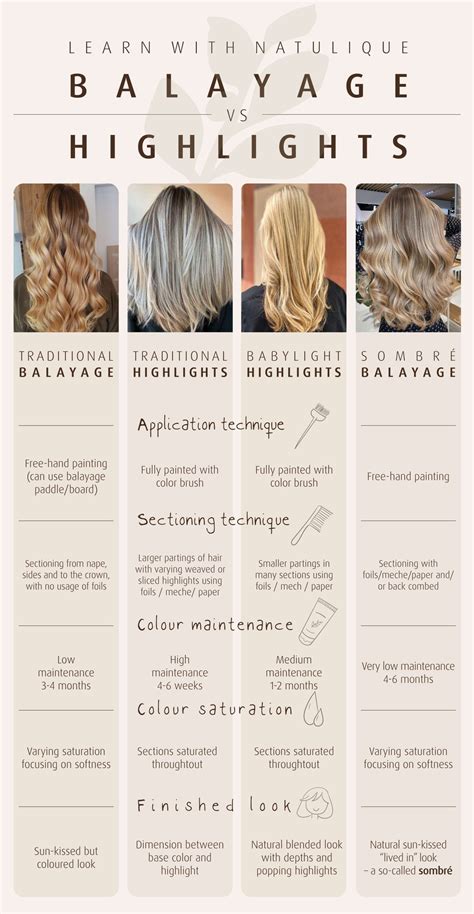When it comes to adding dimension and vibrancy to your hair, there are two popular techniques that stand out: highlights and balayage. Both involve lightening strands of your natural hair, but they differ in their application, results, and maintenance. Let’s delve into the key differences between these popular hair color techniques.

Application: A Matter of Precision
-
Highlights: Highlights are typically applied using foils or a cap, which isolates specific strands for bleaching or coloring. This creates a more structured and defined look with precise placement.
-
Balayage: Balayage, on the other hand, involves freehand painting of the color onto the hair using a brush. This technique allows for a more natural, sun-kissed look with a softer, blended transition between colors.
Results: Subtle vs. Dramatic
-
Highlights: Highlights create a more dramatic transformation by adding distinct, contrasting colors to your hair. They can be placed strategically to frame the face or add dimension to certain areas.
-
Balayage: Balayage provides a subtle, gradual effect that mimics the natural lightening of hair from the sun. It creates a blended, multi-dimensional look with softer transitions and less noticeable roots.
Maintenance: Effort vs. Convenience
-
Highlights: Highlights require more frequent touch-ups as the bleached strands grow out, typically every 6-8 weeks. This can be a time-consuming and potentially damaging process.
-
Balayage: Balayage’s gradual blending makes it less maintenance-intensive. Touch-ups can be pushed out to 12-16 weeks, as the regrowth is less noticeable.
Cost and Time: Balancing Budget and Duration
-
Highlights: Highlights can be more expensive than balayage, especially if they involve multiple colors or complex placement. The application process can also take longer, typically between 2-4 hours.
-
Balayage: Balayage is generally less expensive and time-consuming, with application typically taking around 1-3 hours. However, the cost can increase depending on the length and thickness of your hair.
Which Technique to Choose?
The best hair color technique for you depends on your individual preferences, hair type, and desired look. Consider the following questions to help you make an informed decision:
- Do you want a subtle or dramatic change?
- How much time and effort are you willing to commit to maintenance?
- What is your budget for hair coloring?
Key Differences Summarized
| Feature | Highlights | Balayage |
|---|---|---|
| Application | Foils or cap | Freehand painting |
| Results | Precise, contrasting | Blended, natural |
| Maintenance | Frequent touch-ups | Less frequent |
| Cost | More expensive | Less expensive |
| Time | Longer application | Shorter application |
Tips and Tricks for a Salon-Worthy Finish
- Choose the right color: Consult with a professional colorist to determine the optimal shades for your skin tone and hair type.
- Protect your hair: Use heat protectants and color-safe shampoos and conditioners to maintain the health of your colored hair.
- Experiment with different techniques: Combine highlights and balayage for a customized, multi-dimensional look.
- Embrace the natural: Balayage is perfect for creating a low-maintenance, sun-kissed effect that complements natural tones.
Common Mistakes to Avoid
- Over-bleaching: Avoid excessive bleaching, which can damage your hair and result in breakage.
- Uneven application: Ensure that your highlights or balayage are applied evenly to avoid patchy results.
- Ignoring root maintenance: Neglecting touch-ups can lead to noticeable roots and a dull appearance.
- Improper care: Using harsh chemicals or heat styling tools without protection can strip your hair of color and moisture.
Conclusion
Whether you opt for the precision of highlights or the natural softness of balayage, understanding the key differences between these techniques will help you achieve the perfect hair color for your style and lifestyle. Embrace the transformative power of hair coloring and experiment with different options to find the one that makes you feel most confident and radiant.
